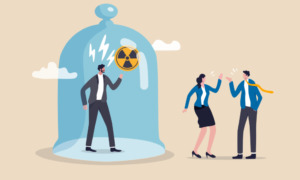As the Nobel Peace Prize in Al Gore’s trophy case will attest, being green is officially hip again. But environmental friendliness was not the top priority when Family Services broke ground on its new home last year in Winston-Salem, N.C.
Nevertheless, the nonprofit’s headquarters will feature lights that dim as more sunlight comes through the windows, and a green heating, ventilation and air-conditioning system.
While such gee-whiz features used to be luxuries that only well-off companies could afford, CEO Alfred Renna believes his new building will be friendly to his nonprofit’s bottom line as well. He expects its operations to cost 15 percent less than at the current building.
With the Troy, Mich.-based Kresge Foundation leading the charge – and environmentally minded corporations looking to help – the time has never been better for youth-serving organizations that own their buildings to turn those buildings green.
That doesn’t mean everyone can swing the cost. Who has $250,000 for a geothermal water system, except for the Shenandoah Valley Juvenile Detention Center in Virginia?
But the up-front costs are becoming less prohibitive, while the payoffs are growing. So in Delaware, the Girl Scouts of the Chesapeake Bay Council can afford a water system in its new lodge that collects rain and used sink water for re-use in the toilets.
In Ferndale, Mich., the Affirmations community center for gay youth and adults can install skylights and motion-sensor lighting that help cut the building’s utility costs by 20 percent.
Elsewhere in Michigan, the YMCA of Greater Grand Rapids built a new $25 million branch to green standards, then passed a rule requiring all new sites to be built that way. Two are in the works.
"This is about creating buildings that lower operating costs, that have higher occupant health outcomes and productivity," says Sandy Ambrozy, program director for Kresge’s green building initiative. Growing Green construction is the practice of constructing or renovating buildings to maximize energy efficiency and health.
That’s accomplished by using designs, materials and infrastructure that allow buildings to use less energy and water and emit fewer harmful chemicals. Green building also includes more selective removal of construction debris, which reduces the amount of waste sent to landfi lls.
The practice is growing. In 2006, the U.S. Green Building Council (USGBC) had 6,300 projects registered to achieve its Leadership in Energy and Environmental Design (LEED) certification, the rating system for environmentally sustainable building.
This year, more than 11,000 projects are registered. Those projects include about 50 youth-serving programs (not counting schools and children’s hospitals).
Behind the efforts at many nonprofits is Kresge, a grant maker (assets: $3.4 billion) that launched a shortterm initiative on nonprofit green building in 2003, "when sustainable design was still a novelty," Ambrozy says. "Kresge deserves real [credit] for getting the nonprofit sector turned on to this," says Jenn Rezeli, co-owner of Re:Vision, a Philadelphia-based architectural firm that works on environmentally friendly projects. "I can’t tell you how many organizations have told me that Kresge is who piqued their interest in green building."
Kresge began with an education campaign, developing five brochures on green building and producing a series of nine workshops around the country with the Nonprofit Finance Fund. That was followed by an investment in 42 programs Kresge seeded to serve as models for the strategy.
Each program got construction funding from Kresge’s Capital Challenge funding pool (often a grant of $400,000), along with the promise of another $150,000 if they achieve basic LEED certification, and another $100,000 if they can reach the two highest notches on the LEED rating system (platinum or gold).
The foundation has made more than $12 million in grants, including grants to 16 youth work organizations.
Easy Steps
One of the Kresge grantees is the Chesapeake Bay Girl Scouts, whose new science and technology lodge is under construction in Hockessin, Del. The $1.8 million lodge includes a weather station, laboratory, water garden and outdoor deck camping area. It features solar panels (donated by Delmarva Power), a water system that collects rain water and spent sink water for re-use as toilet waste, and Biobased spray foam insulation.
The architecture firm, Re:Vision, expects that insulation to improve the lodge’s energy efficiency by at least 30 percent over an average building.
The lodge and the Winston Salem Family Services building, which is also just beginning construction, both feature two elements that are the easiest to implement: Green positioning and architectural design – Both buildings have been positioned to maximize the amount of heat and light harvested from the sun, in order to cut down on the use of internal lighting and heating.
"A lot of green building is just good planning," Family Services CEO Renna says. "It’s maximizing your heating and cooling ability." This is best achieved by positioning the building so that the largest openings are drawing a maximum amount of sunlight.
"When coupled with proper passive design strategies such as strategic window openings, high-performance glazing and appropriate overhangs, a building’s orientation can impact heating/cooling loads by up to 30 percent," says Rezeli of Re:Vision.
Efficient waste removal – Everyone has seen the pile of waste that amasses at the average construction site. Usually, at last half of that pile is reusable. Recycling materials by simply organizing scraps and used materials can lower the landfill fees paid by contractors, who often pass those fees on to clients. Scrap metal, concrete, asphalt, steel, glass and felled trees can all make their way back into building projects or go to the recycling plant, Rezeli says.
For example: Old concrete and asphalt can be used as base fill under a pervious parking lot, which allows water to drain into the ground instead of adding to storm water runoff. Felled trees and some old wallboards can be chipped up into mulch.
Costs
Family Services’ green aspirations almost stopped in the planning stages. Renna saw green building as a logical extension of the group’s mission as a tax-exempt service organization, and also as a possible extension of his donor base. But he didn’t have an easy time convincing his board that the costs would be worth it. That’s a typical situation in green building deliberations. Kresge’s initial research confirmed two barriers to nonprofits building green, says Ambrozy, Kresge’s green initiative program director: "It was perceived as too costly, and there was a serious lack of information" about the process.
The architect’s projections surprised everyone at Family Services: A green approach would cost just one-half percent more (about $30,000) than an alternative plan, architect Kyle Troxell told Renna. The added costs should be paid for by the building’s third year, through savings from increased efficiency.
With a capital campaign still going on as construction began recently, Renna says 5 percent of the contributions came from donors who contributed only because it was a green building project. "That’s not nothin’," he says.
At the YMCA of Greater Grand Rapids, where the first LEED-certified YMCA branch was completed in 2005, Chief Operating Officer Don McCarthy says almost one-third of the capital campaign donations came from funders who donated specifically because the project was environmentally friendly.
John Hunting, a local environmentally conscious philanthropist, brought the idea of a LEED-certified building to the YMCA – then joined his brothers to donate $5 million toward the construction of that facility. McCarthy says several other six- and seven-figure gifts would not have been given were it not for the green approach. Recent research has challenged notions about the cost of environmental construction.
"Cost of Green Revisited," a study by construction cost management firm Davis Langdon, found that "many projects are achieving LEED within their budgets, and in the same cost range as non-LEED projects."
In other words, green building is significantly more expensive only when compared with a project that is intentionally done on the cheap. Otherwise, the difference is negligible.
"The premium [for green planning] is small if your base budget is for good quality," says Rezeli of Re:Vision. "But compared to the bottom of the barrel, yeah, it’s going to be more expensive."
For cash-strapped businesses, the Langdon report says, the most significant barrier to green building is the recent boom in overall construction costs. That raises the price tag on any project, green or not, and forces agencies with meager budgets to consider Rezeli’s bottom-of-the-barrel options.
Or to go just somewhat green, forgoing some of the more expensive items. For example, the Girl Scouts of Chesapeake Bay couldn’t afford a geothermal heating system, which uses water heated in tanks sunk deep into the ground. That’s unfortunate in the long run, because geothermal tanks are one of the best cost-savers in the industry. The Shenandoah Valley Juvenile Detention Center in Staunton, Va., featured a geothermal system when it opened in 2004.
It cost $250,000, putting the project over budget at the time, but Superintendent Tim Smith expects it to pay for itself by 2009.
The Future
Kresge says its environmental construction mission has changed from short-term to long-term, as the foundation becomes increasingly convinced of the benefits. "When we started the program, we didn’t know a lot," Ambrozy says. "We’ve realized that increasingly, [sustainable design] is simply a best practice."
To that end, the grant maker continues to supply up to $100,000 for green building planning grants, with the incentive that it will strongly consider funding the planned projects out of its core capital funds. Ambrozy says promoting green renovations – a scenario far more feasible than new construction for many youth-serving organizations – is "the next frontier."
One-third of the grantees in the foundation’s planning grants program provide human services, the foundation says. About onequarter of the projects borne of those planning grants are for less than $1.7 million each.
Youth serving agencies, Ambrozy says, "can see themselves in there."
Green Youth Projects
Below is a selected sample of agencies and programs that have registered for the Leadership in Energy and Environmental Design (LEED) certification from the U.S. Green Building Council. A complete list of projects can be found at www.usgbc.org. Click on LEED, then LEED Project Lists.
- Gaithersburg Youth Center, City of Gaithersburg, Md.
- Mecklenburg County Youthful Offenders, Mecklenburg County, Charlotte, N.C.
- Pala Youth Center, City of San Jose, Calif.
- Park Place Outreach Home-Youth Shelter, Park Place Outreach Inc., Savannah, Ga.
- Camp Greenkill, YMCA of Greater New York, Huguenot, N.Y.
- Headquarters and Training Program Center, Girl Scouts of Gulfcoast Florida, Sarasota, Fla.
- Springwood Youth Center, King County Housing Authority, Kent, Wash.
- Nanakuli Youth Education Town Center, Boys & Girls Club of Hawaii, Honolulu, Hawaii
- West Cambridge Youth and Community Center, City of Cambridge, Mass.
- Carriage House Children’s Center, Pittsburgh
- DA Blodgett Children’s Home, Inner City Christian Federation, Grand Rapids, Mich.
- Valley of the Moon Children’s Home, Santa Rosa, Calif.
- Grand Strand YMCA of Coastal Carolina, Myrtle Beach, S.C.
- United Teen Equality Center, Lowell, Mass.
- Bellevue Boys & Girls Club, Bellevue, Wash.
Resources
The Kresge Foundation Troy, Mich. (248) 643-9630 www.kresge.org
U.S. Green Building Council Washington, D.C. (800) 795-1747 www.usgbc.org
Re:Vision Philadelphia, Pa. (215) 482-1133 www.revisionarch.com






























